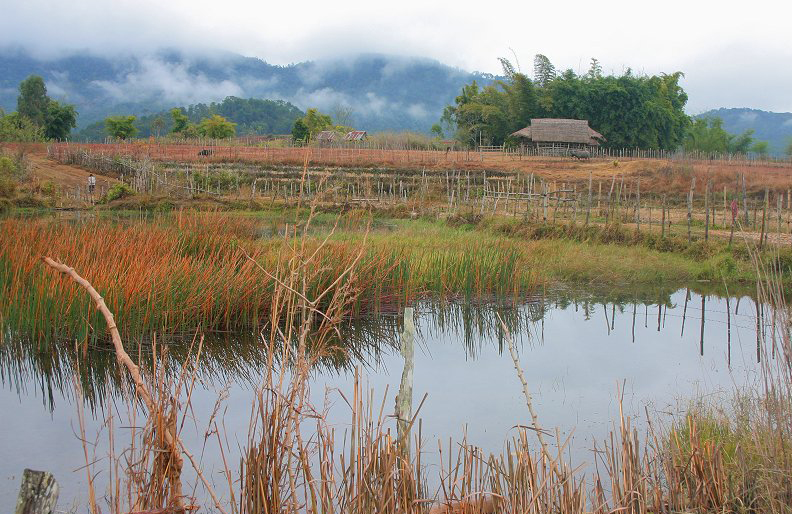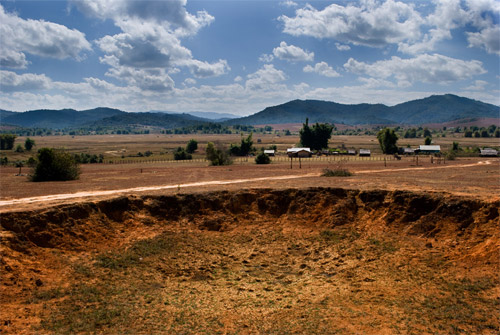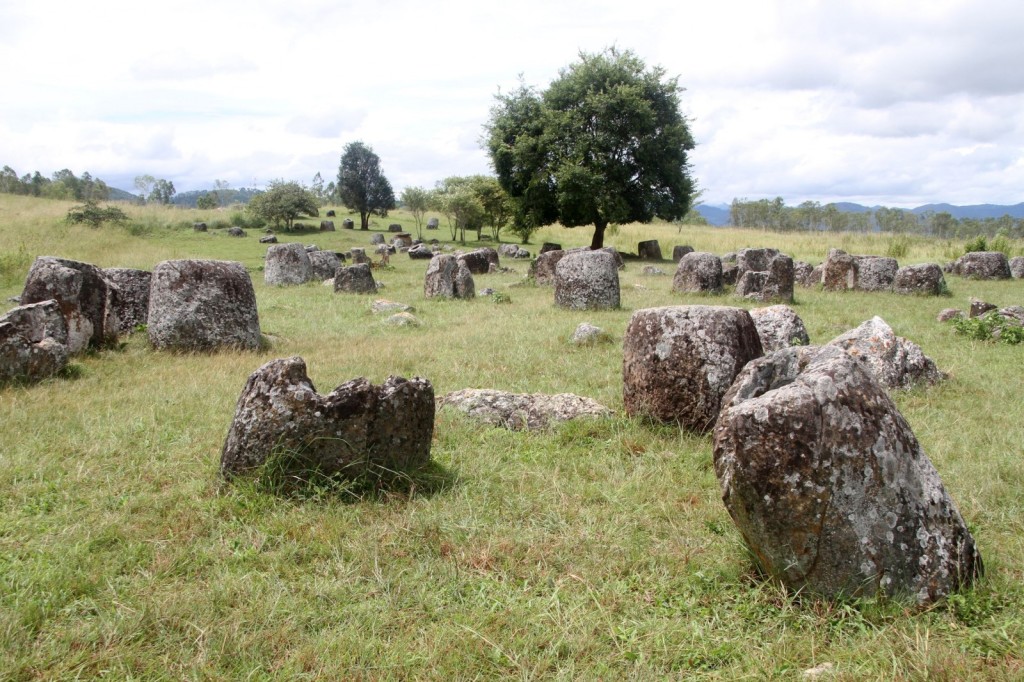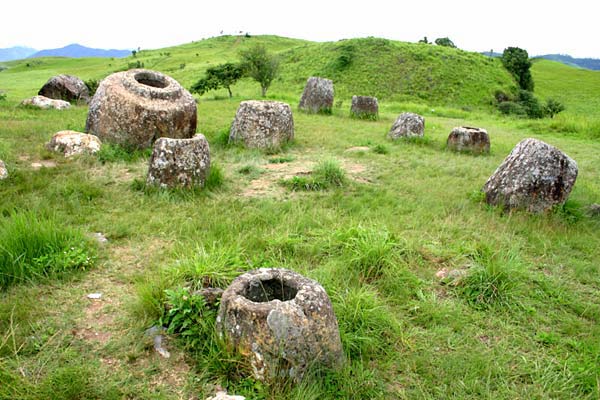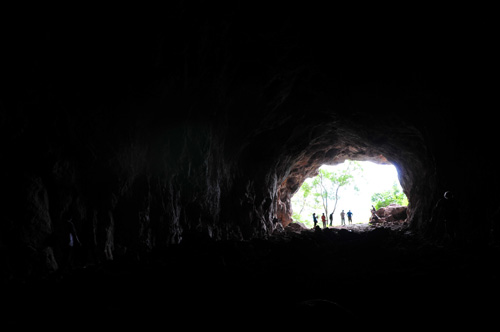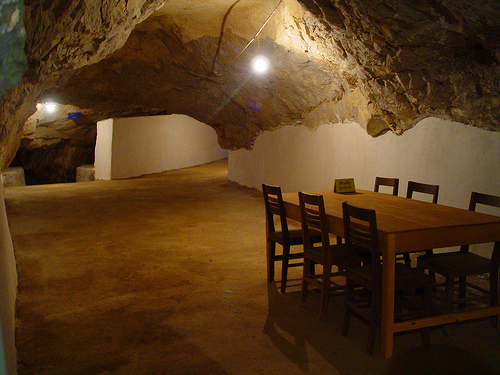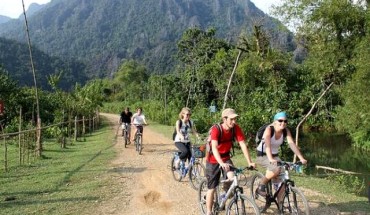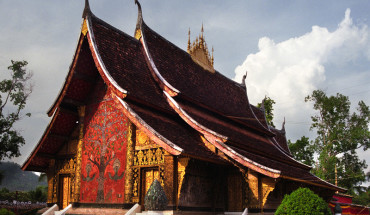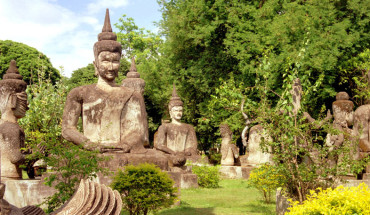Apart from the historic Plain of Jars, Xieng Khouang Province is best known for the pounding it took during the war. Many of the sights are battered monuments to the plateau’s violent recent history.
Given the cost of the return trip and the fact that the jars themselves aren’t that spectacular, some consider the destination oversold. However, further east, and near border crossings with Vietnam, are the Vieng Xai Caves, the Pathet Lao subterranean headquarters during the Secret War. For those interested in modern history, it’s the most fascinating area of Laos and helps one to gain an insight into the resilient nature of the Lao people. The countryside, particularly towards the Vietnam frontier, is beautiful among the country’s best and the jars, too, are interesting by their very oddness: as if a band of carousing giants had been suddenly interrupted, casting the jars across the plain in their hurry to leave. The caves’ history is fascinating and brought to life by brand new audio tours.
Background
Xieng Khouang Province has had a murky, blood-tinted, war-ravaged history. The area was the most bombed province in the most bombed country, per capita, in the world as it became a very important strategic zone that both the US and Vietnamese wanted to retain control of. The town of Phonsavanh has long been an important transit point between China to the north, Vietnam to the east and Thailand to the south and this status made the town a target for neighboring countries. What’s more, the plateau of the Plain of Jars is one of the flatter areas in northern Laos, rendering it a natural battleground for the numerous conflicts that ensued from the 19th century to 1975. While the enigmatic Plain of Jars is here, this region will also hold immense appeal for those interested in the modern history of the country.
Once the French departed from Laos, massive conflicts were waged in 1945 and 1946 between the Free Lao Movement and the Viet Minh. The Pathet Lao and Viet Minh joined forces and, by 1964, had a number of bases dotted around the Plain of Jars. From then on, chaos ensued, as Xieng Khouang got caught in the middle of the war between the Royalist-American and Pathet Lao-Vietnamese. The extensive US bombing of this area was to ensure it did not fall under the Communist control of the Pathet Laos. The Vietnamese were trying to ensure that the US did not gain control of the area from which they could launch attacks on North Vietnam.
During the ‘Secret War’ (1964-1974) against the North Vietnamese Army and the Pathet Lao, tens of thousands of cluster bomb units (CBUs) were dumped by the US military on Xieng Khouang Province. Other bombs, such as the anti-personnel plastic ‘pineapple’ bomb lets were also used but by and large cluster bombs compromised the majority dropped. The CBU was a carrier bomb, which held 670 sub-munitions the size of a lemon. As the CBU was dropped each of these smaller bombs was released. Even though they were the size of a tennis ball, they contained 300 metal ball-bearings that were propelled hundreds of meters. As 30% of the original bombs did not explode, these cluster bombs continue to kill and maim today. The Plain of Jars was also hit by B-52s returning from abortive bombing runs to Hanoi, who jettisoned their bomb loads before heading back to the US air base at Udon Thani in northeast Thailand. Suffice it to say that, with over 580,944 sorties flown (1, 5 times the number flown in Vietnam), whole towns were obliterated and the area’s geography was permanently altered. Today, as the Lao Airlines plane begins its descent towards the plateau, the meaning of the term ‘carpet bombing’ becomes clear. On the final approach to the town of Phonsavanh, the plane banks low over the cratered paddy fields, affording a T-28 fighter-bomber pilot’s view of his target, which in places has been pummeled into little more than a moonscape. Some of the craters are 15 m across and 7 m deep. Testament to the Lao people’s resilience, symbolically, many of these craters have been turned into tranquil fish ponds; the bombs transformed into fences and the CBU carriers serving as planter pots. Because the war was ‘secret’, there are few records of what was dropped and where and, even when the unexploded ordnance (UXO) have been uncovered, their workings are often a mystery – the Americans used Laos as a testing ground for new ordnance so blueprints are unavailable.
The UK-based Mines Advisory Group (MAG) UXO Visitor Information Centre on the main road in the centre of town is currently engaged in clearing the land of UXO. They have an exhibition of bombs, photographs and information on the bombing campaign and ongoing plight of Laos with UXO. Usually there are staffs on hand to explain exactly how the bombs were used. All T-shirts sold here help fund the UXO clearance of the area and are a very worthwhile souvenir.
Xieng Khouang remains one of the poorest provinces in an already wretchedly poor country. The whole province has a population of only around 250,000, a mix of different ethnic groups, predominantly Hmong, Lao and a handful of Khmu.
Trekking and biking opportunities have opened up in the area with the help of a German NGO. Contact the Xieng Khouang Provincial Tourism Department 2 km from the town centre, [email protected], for the Xieng Khouang Discovery Guide or local tour operators.
Plain of Jars and Phonsavanh
The undulating plateau of the Plain of Jars (also known as Plaine de Jarres or Thong Hai Hin) stretches for about 50 km east to west, at an altitude of 1000 m. In total there are 136 archaeological sites in this area, containing thousands of jars, discs and deliberately placed stones, but at the moment only three principal sites are open to tourists. The plateau can be cold from December to March. Phonsavanh is the main town of the province today old Xieng Khouang having been flattened – and its small airstrip is a crucial transport link in this mountainous region. It’s the only base from which to explore the Plain of Jars, so it has a fair number of hotels and guesthouses. Note that travel agents and airlines tend to refer to Phonsavanh as Xieng Khouang, while the nearby town of ‘old’ Xieng Khouang is usually referred to as Muang Khoune.
Arriving in Plain of Jars and Phonsavanh
Getting there Phonsavanh Airport (aka Xieng Khouang Airport) is 4 km west of Phonsavanh – there are flights from Vientiane five times per week. The most direct route by road from Luang Prabang to Xieng Khouang is to take Route 13 south to Muang Phou Khoun and then Route 7 east. An alternative, scenic, albeit convoluted, route is via Nong Khiaw, from where there are pickups to Pak Xeng and Phonsavanh via Vieng Thong on Route 1 or Nam Nouan.
The bus station is 4 km west of Phonsavanh on Route 7
Getting around Public transport is limited and sporadic. Provincial laws have occasionally banned tuk-tuks and motorbikes from ferrying customers around the area. It should be possible to drive from Phonsavanh to the Plain of Jars, see Site one below, and return to town in two hours. Alternatively, guesthouses and tour companies in Phonsavanh run set tours to the Plain of Jars. If you arrive by air, the chances are you’ll be inundated with official and unofficial would-be guides as soon as you step off the plane. Note that it is not possible to walk from the airport to Site one, as there is a military base in between. It is recommended that you hire a guide, for at least a day, to get an insight into the history of the area. There is an interesting exhibition by MAG at site one.
Background
Most of the jars are between 1 m and 2.5 m high, around 1 m in diameter and weigh about the same as three small cars. The largest are about 3 m tall. The jars have long presented an archaeological conundrum, leaving generations of theorists nonplussed by how they got there and what they were used for. Local legend relates that King Khoon Chuong and his troops from Southern China threw a stupendous party after their victory over the wicked Chao Angka and had the jars made to brew outrageous quantities of lao-lao. However, attractive as this alcoholic thesis is, it is more likely that the jars are in fact 2000-year-old stone funeral urns. The larger jars are believed to have been for the local aristocracy and the smaller jars for their minions. Tools, bronze ornaments, ceramics and other objects have been found in the jars, indicating that a civilized society was responsible for making them but no one has a clue which one, as the artifacts seem to bear no relation to those left behind by other ancient Indochinese civilizations. Some of the jars were once covered with round lids and there is one jar, in the group facing the entrance to the cave, which is decorated with a rough carving of a dancing figure.
The sites
Site one More than 334 jars survive, mainly scattered on one slope at so-called ‘Site one’ or Thong Hai Hin, 10 km southwest of Phonsavanh. This site hosts the largest jars. A path, cleared by MAG, winds through the site, with a warning not to walk away from delineated areas as UXO are still around. Each of the jars weighs about a tonne, although the biggest, called Hai Cheaum, is over 2 m tall and weighs over six tonnes.
Site two True jar lovers should visit Site two, known as Hai Hin Phu Salatao (literally ‘Salato Hill Stone Jar Site’) and Site three called Hai Hin Laat Khai.
Site two is 25 km south of Phonsavanh and features 90 jars spread across two hills. The jars are set in a rather beautiful location, affording scenic 360-degree views. Most people miss this site but it is in fact the most atmospheric because of the hilltop location. On the second hill, trees have grown through the centre of the jars, splitting them four ways; butterflies abound.
Site three A further 10 km south of Site two, Site three is the most peaceful, set in verdant green rolling hills, Swiss-cheesed with bomb craters. To get there you have to walk through some rice paddies and cross the small bamboo bridge. There are more than 130 jars at this site, which are generally smaller and more damaged than at the other sites. There’s also a very small, basic restaurant, serving feu (noodle soup).
Tham Piu
The cave is to the west of the Muang Kham-Xam Neua Rd, just after the 183 km post. A rough track leads down to an irrigation dam, built in 1981. To get there from Phonsavanh you can either go the easy way and hire a vehicle, or go the hard way, by public transport. For the latter, take the bus to Nong Haet, and request to stop at the Tham Phiu turn-off. From here walk towards the towering limestone cliff and follow the small trails for the last kilometre. It is best to do this with a guide as UXOs still litter the area.
This cave is more of a memorial than a tourist site but will be of interest to those fascinated by the war. More evidence of the dirty war can be seen here. The intensity of the US bombing campaign under the command of the late General Curtis Le May was such that entire villages were forced to take refuge in caves. If discovered, fighter bombers were called in to destroy them. In Tam Phiu, a cave overlooking the fertile valley near Muang Kham, 374 villagers from nearby Ban Na Meun built a two-storey bomb shelter and concealed its entrance with a high stone wall. They lived there for a year, working in their rice fields at night and taking cover during the day from the relentless bombing raids that killed thousands in the area. On the morning of 24 November 1968 two T-28 fighter-bombers took off from Udon Thani air base in neighboring Thailand and located the cave mouth that had been exposed on previous sorties. It is likely that the US forces suspected that the cave contained a Pathet Lao hospital complex. Indeed, experts are at odds whether this was a legitimate target or an example of collateral damage. There are a few people still alive whose families died in the cave, and they certainly see it as innocent civilians being targeted. The first rocket destroyed the wall, the second, fired as the planes swept across the valley, carried the full length of the chamber before exploding. There were no survivors and 11 families were completely wiped out; in total 374 people died, many reportedly women and children. Local rescuers claim they were unable to enter the cave for three days, but eventually the dead were buried in a bomb crater on the hillside next to the cave mouth.
You will need a torch to explore the cave but there isn’t much inside, just eerily black walls. The interior of the cave was completely dug up by the rescue parties and relatives and today there is nothing but rubble inside. It makes for a poignant lesson in military history and locally it is considered a war memorial.
Further up the cliff is another cave, Tham Phiu Song, which fortunately didn’t suffer the same fate. Before the stairway to the caves there is a little memorial centre that displays photographs from the war and is usually attended by a relative of the victims. A poignant sculpture of a soldier carrying a dead child marks the site, free of the victory and glory of most other war monuments. Many bomb craters around the site have been turned into fish ponds now bearing beautiful lotus.
Vieng Xai (Viengsay)
The village of Vieng Xai lies 31 km east of Xam Neua on a road that branches off Route 6 at Km 20. The trip from Xam Neua is possibly one of the country’s most picturesque journeys, passing terraces of rice, pagodas, copper- and charcoal-colored karst formations, dense jungle with misty peaks and friendly villages dotted among the mountains’ curves. The area is characterized by lush tropical gardens, a couple of smallish lakes and spectacular limestone karsts, riddled with natural caves that proved crucial in the success of the left-wing insurgency in the 1960s and 1970s.
Getting there Tourists are often put off visiting Hua Phan Province by the long bus haul to get there but, considering the road passes through gorgeous mountain scenery, the trip is well worth the endeavor. There are three main sealed roads to Xam Neua: Route 6 from the south, linking Xam Neua with Phonsavanh; Route 1 from Vieng Thong and the west, and Road 6A from the Vietnamese border. Due to the upgrading of Route 6, it is now possible to make the journey between Phonsavanh and Xam Neua in a day without an overnight stop in Nam Nouan en route but always check on road conditions before setting off. There is an airport at Xam Neua, 3 km from the centre of town on the road to Vieng Xai and Vietnam.
Visiting the caves
There eight caves open to visitors. Five were formerly occupied by senior Pathet Lao leaders (Prince Souphanouvong, Kaysone Phomvihan, Nouhak Phounsavanh, Khamtai Siphandon and Phoumi Vongvichit). All the caves are within walking distance of the village. If you pitch up out of these hours. Tours are usually conducted on bikes which can be rented from the office if you don’t have your own transport. Tours last between three to four hours A new set of excellent 90-minute audio tours with personal memories of local people included has launched and is included in the tour. A taster can be heard on: www.visit-viengxay.com. If you plan on coming across from Xam Neua it is advisable to stay overnight.
From 1964 onwards, Pathet Lao operations were directed from the cave systems at Vieng Xai, which provided an effective refuge from furious bombing attacks. The village of Vieng Xai grew from four small villages consisting of less than 10 families into a thriving hidden city concealing over 20,000 people in in the 100 plus caves in the area. The Pathet Lao leadership renamed the area Vieng Xai, meaning ‘City of Victory’ and it became the administrative and military hub of the revolutionary struggle.
The caves have a secretive atmosphere, with fruit trees and frangipani decorating the exteriors. Each one burrows deep into the mountainside and features 60-cm-thick concrete walls, encompassing living quarters, meeting rooms, offices, dining and storage areas. The caves are lit but you may find a torch useful.


